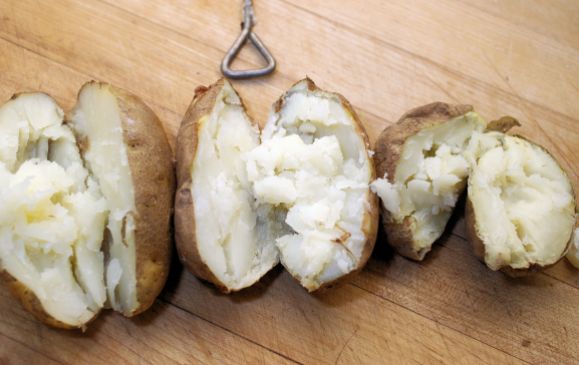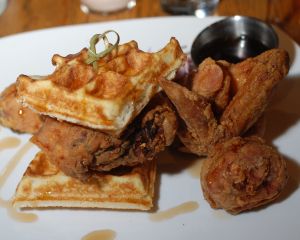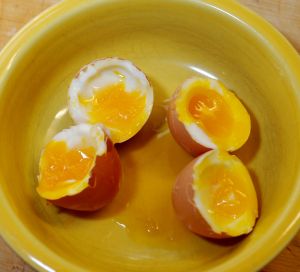 Dan Barber is a highly regarded chef with substantial experience who is known for his two restaurants, Blue Hill in New York and Blue Hill at Stone Barns in Westchester (Pocantico Hills). Both restaurants emphasize creative uses of vegetables and grains and de-emphasize meat, although their menus certainly include it, and represent some of the best examples of “farm to table cooking.”
Dan Barber is a highly regarded chef with substantial experience who is known for his two restaurants, Blue Hill in New York and Blue Hill at Stone Barns in Westchester (Pocantico Hills). Both restaurants emphasize creative uses of vegetables and grains and de-emphasize meat, although their menus certainly include it, and represent some of the best examples of “farm to table cooking.”
His book, The Third Plate is an entertaining description of his restaurant and the accompanying farm give you some great insights into how great chefs think. Unfortunately, his book has some serious fallacies that diminish its credibility as we describe later below.
Barber’s Pocantico Hills restaurant is located on the former Rockefeller estate. The renovation of the buildings as well as the accompanying working farm was funded by David Rockefeller, apparently to the tune of about $30 million. The book tells the story of how Barber’s Stone Barns restaurant developed in association with the farm, where they have the freedom to try out and breed unusual historical vegetables and grains. This “third plate” refers to an evolution in cooking from plates with meat and some small veggies on the side, to meat with better tasting and better cooked veggies, to some imagined future plate where the “steak” is made from vegetables and meat becomes a side dish.
Currently, Stone Barns offers one or two prix fixe menus, which for two with wine pairings, tax and tip can cost you as much as $898. With those prices in mind, you have to recognize that there are a lot of us who will probably never eat there. The reviews for that restaurant are exceptional and apparently so is the food. An evening’s dinner may consist of ten or more courses, starting with small servings of grains or vegetables, with meat in later courses. The menu varies frequently and may vary with each table depending on how the waiters feel you are appreciating what you have just been served
Barber is a good writer and story teller, and the book describes his work with the farmer and with plant breeders to develop and introduce the grains served in the restaurant, starting with the heirloom Eight Row Flint Corn, which was grown by early settlers but had all but vanished at the time he started.
His book is nominally divided into four sections: Soil, Land, Sea, and Seed, but the discussions flow freely around these ideas and you are likely to find some topics revisited in each section.
Foie gras
After his initial soil and farming discussions, Barber spends several chapters on foie gras, with a long bucolic description of a farm in Spain where geese are not force fed, but simply provided with sufficient food all summer and then naturally gorge on acorns in the fall. The farmer, Eduardo Sousa, simply talks to his geese to get them to do what he wants: and some call him a “goose whisperer.”
Then Barber visits the Hudson Valley Foie Gras company with Eduardo, and finds that the goose feeding is not cruel at all, where the “force feeding” (gavage) takes only about 5 seconds per bird (ducks in this case). The kicker in this otherwise rather fascinating tale is that Eduardo decides that the Hudson valley ducks “didn’t know they were ducks.” And that Barber segues from that bizarre conclusion to his own: “What’s intolerable is the system of agriculture that it reflects.”
It is at this point that I lost touch with Barber’s point of view. Raising geese for slaughter one way or another, as long as they are humanely treated, seems to me completely comparable and I have no idea what he is getting at.
Fish Farming
Barber devotes over 100 pages to the sea and buying and cooking seafood sustainably, since many popular fish like bluefin tuna are threatened by overfishing. He visits the well-regarded chef Angel Leon of Aponiente on the Iberian Peninsula, who has learned how to cook the fishing fleet’s discarded by-catch, seasoning it with a phytoplankton broth. Barber also visits the fish farm Veta La Palma, where they raise fish in existing ponds and canals, where the fish are mostly fed from nutrients that occur naturally, producing some of the most sought after sea bass in Europe (and eventually the US).
He also describes the almadraba in Cadiz, where the villagers have been capturing migrating tuna using mazes of nets for hundreds, if not thousands of years.
He also spends some time praising Gilbert Le Coze, the founding chef of New York’s pre-eminent seafood-only restaurant, Le Bernardin, but for some reason avoids mentioning for many pages that Le Coze died in 1994, and that Eric Ripert, the chef since 1994, is principally responsible for Le Bernardin’s current exalted status in the food world.
Barber also tells us the story of Glenn Roberts and his founding of Anson Mills to produce artisanal grains, including graham flour (a kind of wheat) and revitalizing Carolina Gold rice, where they discover that the crops grown in conjunction with the wheat or rice affect the flavor of the grain.
Fallacies
While Barber’s book is entertaining enough to plow through in a day or two, there are some real problems with some of what he tells us. Starting early on and repeating throughout is Barber’s insistence on the superiority of organic farming, although he provides no good reason for that, and does not acknowledge that “organic” is a USDA marketing label that allows you to charge higher prices rather than a set of superior techniques. At no point does he explain why the farm is “organic” nor why the farm would be less successful had they chosen careful conventional farming techniques.
Studies (USDA data) have shown that organic farming yield 50-75% as much as conventional farming, and that the produce is no safer or more nutritious or flavorful than conventional produce. This is simply the naturalistic fallacy promoted by the organic marketing associations.
One of the first anecdotes in the book describes farmer Klaas Martens, who had been farming conventionally for some years and suddenly developed a sort of weakness in his arms after spraying 2,4-D. According to the story, no doctors were able to diagnose his ailment, but this caused him to switch to organic farming because as his wife said, “he was being poisoned.”
The trouble with Martens’ story is that it contradicts all known toxicology data on 2,4-D. The National Pesticide Information Center fact sheet on 2,4-D says the “No occupational studies were found reporting signs or symptoms following exposure to 2,4-D under normal usage,” and even on acute oral exposure (drinking it) no symptoms like Martens had are observed. Since Martens condition was never diagnosed, we have to take this as mere rumor.
One particularly offensive statement later in the book comes from a young farmer who comes to Barber saying that “My father just got cancer, so I am switching to organic farming.”
Throughout the book, Barber continually mentions chemicals used in conventional farming as “poisoning the soil.” Since more than 98% of all farms in the US are conventional, this would imply that they must all be failing. Now, since most farmers have at least bachelor’s degrees and well understand how important caring for their soil is, this is pretty ridiculous. We would all be starving if this were true.
Even more ridiculous is Barber’s quote from Rudolf Steiner, who hatched the idea of biodynamic farming out of a series of mystical rituals, such as burying oak bark in a cow’s skull in the middle of your field. Steiner also had a lot of other crazy theories such as the one Barber quotes with a straight face, that the heart is not a pump for our blood, but that the blood that drives the heart. To support this nonsense he quotes “holistic practitioner” Thomas Cowan, who is deep into the same nonsense and Sally Fallon Morell of the discredited Weston A Price Foundation.
Barber is no friend of biotechnology either, making it clear he would never serve any genetically modified food in his restaurant (this is pretty hard to accomplish, actually). His example is the 2009 infestation of Late Blight that devastated everyone’s tomatoes in the Northeast. There was one small patch of tomatoes on the farm that were not affected, Mountain Magic, an experimental seed from Cornell, bred to be blight resistant. (You can buy these from several seed catalogs today.) But Barber’s restaurant customers resisted them, fearing that they might be “genetically engineered.” He decided he needed to perpetuate the fallacy of tomatoes “bred the old-fashioned way at a land grant like Cornell, [versus] GM tomatoes from a company like Monsanto.”
The only GM tomato ever marketed was the Flavr Savr tomato, bred to be shipped ripe rather than green. Eventually, the tomato failed, but not because it didn’t have better flavor as Barber says, but because Calgene had trouble keeping costs down so it would be competitive.
Finally, Barber is skeptical about the whole idea of the Green Revolution, started by plant breeder and Nobel Peace Prize winner Norman Borlaug. His criticisms on the use of fertilizers to create higher yield seem to echo those of the mendacious non-scientific activist Vandana Shiva.
In fact, Barber is critical of the whole idea of modern agriculture, where farmers buy new seed each year rather than saving seeds from last year. Farmers have not saved seeds since the 1930s, because of the problems of storage and disease control as well as those of controlling new generations of seed. Barber thinks they should all be saving the best seeds from the fields each year on each farm instead, turning each farm into its own primitive seed development company. Few farmers would agree that this is a good division of labor.
In conclusion, Barber has written an entertaining and informative book on the relationship between high end cuisine and small scale agriculture, but seems oblivious to the fact that he and his restaurant are living a bucolic fantasy which can only work on a small scale, with the subsidies of the Rockefeller family and his high-priced restaurant.
Originally published on Examiner.com in September, 2014














 If you want to grill your potatoes, add spikes and throw them on the grill, near, but not on the actual fire source. Yes, the outsides will blacken a bit, but it is worth it for the improvement in flavor and texture. A baked potato should be flakey, like many politicians, but not mushy like some other politicians. It will have a nice pleasing texture and a much better flavor. We found that grilled potatoes took about 20 minutes and had an excellent flavor and texture.
If you want to grill your potatoes, add spikes and throw them on the grill, near, but not on the actual fire source. Yes, the outsides will blacken a bit, but it is worth it for the improvement in flavor and texture. A baked potato should be flakey, like many politicians, but not mushy like some other politicians. It will have a nice pleasing texture and a much better flavor. We found that grilled potatoes took about 20 minutes and had an excellent flavor and texture. The ill-informed
The ill-informed 



 So we tried cooking the eggs at low pressure, reducing the time to 2 minutes. They weren’t sufficiently cooked, so we repeated the experiment at 3 minutes and low pressure. These were actually pretty nice, but again, it was hard to unmold them, and the ramekins were just as hot, so it took some time. Again, the elapsed time was at least 11.5 minutes or more, and while the eggs were cooked well, it was hard not to break them while unmolding them.
So we tried cooking the eggs at low pressure, reducing the time to 2 minutes. They weren’t sufficiently cooked, so we repeated the experiment at 3 minutes and low pressure. These were actually pretty nice, but again, it was hard to unmold them, and the ramekins were just as hot, so it took some time. Again, the elapsed time was at least 11.5 minutes or more, and while the eggs were cooked well, it was hard not to break them while unmolding them.

 We sprayed them with cooking spray as they recommended and cooked 2 eggs for 3 minutes at low pressure. They weren’t done, so we returned them to the pot for one more minute. These were done and looked pretty nice in their silicone cups. But, while the pods weren’t as hot as the glass ramekins, they were very difficult to get the eggs out of. In fact, even though we carefully ran the spatula knife around them, one of them broke. Further, they were hard to center over the toast. While the eggs were cooked properly, getting them out was far too difficult, and we don’t recommend them. This took nearly 12 minutes.
We sprayed them with cooking spray as they recommended and cooked 2 eggs for 3 minutes at low pressure. They weren’t done, so we returned them to the pot for one more minute. These were done and looked pretty nice in their silicone cups. But, while the pods weren’t as hot as the glass ramekins, they were very difficult to get the eggs out of. In fact, even though we carefully ran the spatula knife around them, one of them broke. Further, they were hard to center over the toast. While the eggs were cooked properly, getting them out was far too difficult, and we don’t recommend them. This took nearly 12 minutes.

 Dan Barber is a highly regarded chef with substantial experience who is known for his two restaurants,
Dan Barber is a highly regarded chef with substantial experience who is known for his two restaurants, 









 Taggart Siegel’s 2010 film “Queen of the Sun” about honeybees has been getting a lot of play lately by green, crunchy groups where facts are of little concern. It appears to be a film about how important bees are to our lives, and is made with endless close-ups of bees and honey. Oh, and bees crawling over some naked German hippies.
Taggart Siegel’s 2010 film “Queen of the Sun” about honeybees has been getting a lot of play lately by green, crunchy groups where facts are of little concern. It appears to be a film about how important bees are to our lives, and is made with endless close-ups of bees and honey. Oh, and bees crawling over some naked German hippies.



